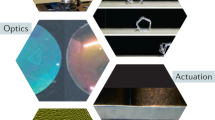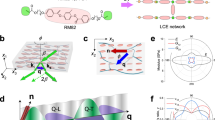Abstract
For liquid crystal elastomers (LCEs), crosslinking is a stress reinforcing factor that sufficiently inhibits macroscopic deformation. In this study, coarse-grained molecular simulations were performed to systematically investigate the dependence of the stress–strain curves of LCEs on the crosslink density. For the unidirectionally oriented initial structure of LCEs, uniaxial elongation was performed in perpendicular or parallel directions. The perpendicularly elongated LCEs demonstrated a characteristic plateau region in the stress–strain curve, indicating soft elasticity. This plateau region corresponds to a large change in the orientational order parameter, indicating that the orientation of mesogens is closely related to soft elasticity. The strain region corresponding to the soft elasticity became narrower as the crosslink density increased. The change in the orientation order parameter also became steeper with increasing crosslink density. On the other hand, the stress values in the plateau region increased with increasing crosslink density. These results indicate a systematic trade-off between stress and strain in the soft elasticity of LCEs, which means that it is possible to select the optimal set of values of stress and the strain range through the crosslink density. Furthermore, the presence of optimal solvent and polymer chain densities that can increase the stress while extending the strain range is indicated.
This is a preview of subscription content, access via your institution
Access options
Subscribe to this journal
Receive 12 print issues and online access
$259.00 per year
only $21.58 per issue
Buy this article
- Purchase on Springer Link
- Instant access to full article PDF
Prices may be subject to local taxes which are calculated during checkout






Similar content being viewed by others
References
Kularatne RS, Kim H, Boothby JM, Ware TH. Liquid crystal elastomer actuators: synthesis, alignment, and applications. J Polym Sci B Polym Phys. 2017;55:395–411. https://onlinelibrary.wiley.com/doi/pdf/10.1002/polb.24287. https://doi.org/10.1002/polb.24287
Herbert KM, Fowler HE, McCracken JM, Schlafmann KR, Koch JA, White TJ. Synthesis and alignment of liquid crystalline elastomers. Nat Rev Mater. 2021;1–16.
Warner M, Bladon P, Terentjev E. “soft elasticity”—deformation without resistance in liquid crystal elastomers. J de Phys II. 1994;4:93–102.
Burke KA, Mather PT. Soft shape memory in main-chain liquid crystalline elastomers. J Mater Chem. 2010;20:3449–57. https://doi.org/10.1039/B924050K
White TJ, Broer DJ. Programmable and adaptive mechanics with liquid crystal polymer networks and elastomers. Nat Mater. 2015;14:1087–98. https://doi.org/10.1038/nmat4433
Ware TH, Biggins JS, Shick AF, Warner M, White TJ. Localized soft elasticity in liquid crystal elastomers. Nat Commun. 2016;7:1–7.
Gelebart AH, Mulder DJ, Vantomme G, Schenning APHJ, Broer DJ. A rewritable, reprogrammable, dual light-responsive polymer actuator. Angew Chem (Int ed Engl). 2017;56:13436–9. https://doi.org/10.1002/anie.201706793.28834188.
Guo Y, Zhang J, Hu W, Khan MTA, Sitti M. Shape-programmable liquid crystal elastomer structures with arbitrary three-dimensional director fields and geometries. Nat Commun. 2021;12:1–9.
Zhang J, Guo Y, Hu W, Soon RH, Davidson ZS, Sitti M. Liquid crystal elastomer-based magnetic composite films for reconfigurable shape-morphing soft miniature machines. Adv Mater. 2021;33:2006191.
Thomsen DL, Keller P, Naciri J, Pink R, Jeon H, Shenoy D, et al. Liquid crystal elastomers with mechanical properties of a muscle. Macromolecules. 2001;34:5868–75. https://doi.org/10.1021/ma001639q
Wermter H, Finkelmann H. Liquid crystalline elastomers as artificial muscles. e-Polym. 2001;1:013 https://doi.org/10.1515/epoly.2001.1.1.111
Buguin A, Li M-H, Silberzan P, Ladoux B, Keller P. Micro-actuators: when artificial muscles made of nematic liquid crystal elastomers meet soft lithography. J Am Chem Soc. 2006;128:1088–9. https://doi.org/10.1021/ja0575070.
Li M-H, Keller P. Artificial muscles based on liquid crystal elastomers. Philos Trans A Math Phys Eng Sci. 2006;364:2763–77. https://royalsocietypublishing.org/doi/pdf/10.1098/rsta.2006.1853. https://doi.org/10.1098/rsta.2006.1853
Urayama K, Honda S, Takigawa T. Deformation coupled to director rotation in swollen nematic elastomers under electric fields. Macromolecules. 2006;39:1943–9. https://doi.org/10.1021/ma052762q
Corbett D, Warner M. Changing liquid crystal elastomer ordering with light – a route to opto-mechanically responsive materials. Liq Cryst. 2009;36:1263–80. https://doi.org/10.1080/02678290903062994
Kato T, Tanabe K. Electro- and photoactive molecular assemblies of liquid crystals and physical gels. Chem Lett. 2009;38:634–9. https://doi.org/10.1246/cl.2009.634
Ohm C, Brehmer M, Zentel R. Liquid crystalline elastomers as actuators and sensors. Adv Mater. 2010;22:3366–87. https://onlinelibrary.wiley.com/doi/pdf/10.1002/adma.200904059. https://doi.org/10.1002/adma.200904059
Winkler M, Kaiser A, Krause S, Finkelmann H, Schmidt AM. Liquid crystal elastomers with magnetic actuation. Macromol Symp. 2010;291–292:186–92. https://onlinelibrary.wiley.com/doi/pdf/10.1002/masy.201050522. https://doi.org/10.1002/masy.201050522
White TJ. Photomechanical effects in liquid crystalline polymer networks and elastomers. J Polym Sci B Polym Phys. 2018;56:695–705. https://onlinelibrary.wiley.com/doi/pdf/10.1002/polb.24576. https://doi.org/10.1002/polb.24576
Shenoy DK, Laurence Thomsen D III, Srinivasan A, Keller P, Ratna BR. Carbon coated liquid crystal elastomer film for artificial muscle applications. Sens Actuators A: Phys. 2002;96:184–8. https://doi.org/10.1016/S0924-4247(01)00793-2
Bispo M, Guillon D, Donnio B, Finkelmann H. Main-chain liquid crystalline elastomers: monomer and cross-linker molecular control of the thermotropic and elastic properties. Macromolecules. 2008;41:3098–108. https://doi.org/10.1021/ma7026929
Urayama K, Kohmon E, Kojima M, Takigawa T. Polydomain−monodomain transition of randomly disordered nematic elastomers with different cross-linking histories. Macromolecules. 2009;42:4084–9. https://doi.org/10.1021/ma9004692
White TJ, Serak SV, Tabiryan NV, Vaia RA, Bunning TJ. Polarization-controlled, photodriven bending in monodomain liquid crystal elastomer cantilevers. J Mater Chem 2009;19:1080–5. https://doi.org/10.1039/B818457G
Lee KM, Smith ML, Koerner H, Tabiryan N, Vaia RA, Bunning TJ, et al. Photodriven, flexural–torsional oscillation of glassy azobenzene liquid crystal polymer networks. Adv Funct Mater. 2011;21:2913–8. https://onlinelibrary.wiley.com/doi/pdf/10.1002/adfm.201100333. https://doi.org/10.1002/adfm.201100333
Ohm C, Haberkorn N, Theato P, Zentel R. Template-based fabrication of nanometer-scaled actuators from liquid-crystalline elastomers. Small. 2011;7:194–8. https://onlinelibrary.wiley.com/doi/pdf/10.1002/smll.201001315. https://doi.org/10.1002/smll.201001315
Okamoto T, Urayama K, Takigawa T. Large electromechanical effect of isotropic-genesis polydomain nematic elastomers. Soft Matter. 2011;7:10585–9. https://doi.org/10.1039/C1SM06372C
Fleischmann E-K, Ohm C, Serra C, Zentel R. Preparation of soft microactuators in a continuous flow synthesis using a liquid-crystalline polymer crosslinker. Macromol Chem Phys. 2012;213:1871–8. https://onlinelibrary.wiley.com/doi/pdf/10.1002/macp.201200276. https://doi.org/10.1002/macp.201200276
Tsuchitani A, Ashida H, Urayama K. Pronounced effects of cross-linker geometries on the orientation coupling between dangling mesogens and network backbones in side-chain type liquid crystal elastomers. Polymer. 2015;61:29–35. https://doi.org/10.1016/j.polymer.2015.01.069
Guin T, Settle MJ, Kowalski BA, Auguste AD, Beblo RV, Reich GW, et al. Layered liquid crystal elastomer actuators. Nat Commun. 2018;9:2531 https://doi.org/10.1038/s41467-018-04911-4
Rešetič A, Milavec J, Domenici V, Zupančič B, Bubnov A, Zalar B. Stress-strain and thermomechanical characterization of nematic to smectic a transition in a strongly-crosslinked bimesogenic liquid crystal elastomer. Polymer. 2018;158:96–102. https://doi.org/10.1016/j.polymer.2018.10.049
He Q, Wang Z, Wang Y, Wang Z, Li C, Annapooranan R, et al. Electrospun liquid crystal elastomer microfiber actuator. Sci Robot. 2021;6:9704.
Mistry D, Traugutt NA, Sanborn B, Volpe RH, Chatham L, Zhou R, et al. Soft-elasticity optimises dissipation in 3D-printed liquid crystal elastomers. Nat Commun. 2021;12:6677.
Mbanga BL, Ye F, Selinger JV, Selinger RL. Modeling elastic instabilities in nematic elastomers. Phys Rev E. 2010;82:051701.
Skačej G, Zannoni C. Main-chain swollen liquid crystal elastomers: a molecular simulation study. Soft Matter. 2011;7:9983–91.
Skačej G, Zannoni C. Molecular simulations shed light on supersoft elasticity in polydomain liquid crystal elastomers. Macromolecules. 2014;47:8824–32. https://doi.org/10.1021/ma501836j
Whitmer JK, Roberts TF, Shekhar R, Abbott NL, de Pablo JJ. Modeling the polydomain-monodomain transition of liquid crystal elastomers. Phys Rev E. 2013;87:020502 https://doi.org/10.1103/PhysRevE.87.020502
Tagashira K, Takahashi K, Fukuda J, Aoyagi T. Development of coarse-grained liquid-crystal polymer model with efficient electrostatic interaction: toward molecular dynamics simulations of electroactive materials. Materials. 2018;11:83. https://doi.org/10.3390/ma11010083
Yasuoka H, Takahashi KZ, Fukuda J-I, Aoyagi T. Molecular architecture dependence of mesogen rotation during uniaxial elongation of liquid crystal elastomers. Polymer. 2021;229:123970.
Brannum MT, Auguste AD, Donovan BR, Godman NP, Matavulj VM, Steele AM, et al. Deformation and elastic recovery of acrylate-based liquid crystalline elastomers. Macromolecules. 2019;52:8248–55. https://doi.org/10.1021/acs.macromol.9b01092
Doi H, Takahashi KZ, Tagashira K, Fukuda J-I, Aoyagi T. Machine learning-aided analysis for complex local structure of liquid crystal polymers. Sci Rep. 2019;9:16370 https://doi.org/10.1038/s41598-019-51238-1
Takahashi KZ, Aoyagi T, Fukuda J-I. Multistep nucleation of anisotropic molecules. Nat Commun. 2021;12:5278. https://doi.org/10.1038/s41467-021-25586-4
Yakacki C, Saed M, Nair D, Gong T, Reed S, Bowman C. Tailorable and programmable liquid-crystalline elastomers using a two-stage thiol–acrylate reaction. Rsc Adv. 2015;5:18997–9001.
Aoyagi T, Sawa F, Shoji T, Fukunaga H, Takimoto J, Doi M. A general-purpose coarse-grained molecular dynamics program. Computer Phys Commun. 2002;145:267–79. https://doi.org/10.1016/S0010-4655(02)00271-0
Swope WC, Andersen HC, Berens PH, Wilson KR. A computer simulation method for the calculation of equilibrium constants for the formation of physical clusters of molecules: application to small water clusters. J Chem Phys. 1982;76:637–49.
Mistry D, Gleeson HF. Mechanical deformations of a liquid crystal elastomer at director angles between 0° and 90°: deducing an empirical model encompassing anisotropic nonlinearity. J Polym Sci Part B: Polym Phys. 2019;57:1367–77.
Oh S-W, Guo T, Kuenstler AS, Hayward R, Palffy-Muhoray P, Zheng X. Measuring the five elastic constants of a nematic liquid crystal elastomer. Liq Cryst. 2021;48:511–20.
Okamoto S, Sakurai S, Urayama K. Effect of stretching angle on the stress plateau behavior of main-chain liquid crystal elastomers. Soft Matter. 2021;17:3128–36.
Warner M, Terentjev EM. Liquid crystal elastomers. London, United Kingdom: Oxford University Press; 2007.
Xiao Y-Y, Jiang Z-C, Hou J-B, Zhao Y. Desynchronized liquid crystalline network actuators with deformation reversal capability. Nat Commun. 2021;12:624.
Acknowledgements
This paper is based on results obtained from a project (JPNP16010) commissioned by the New Energy and Industrial Technology Development Organization (NEDO).
Author information
Authors and Affiliations
Corresponding author
Ethics declarations
Conflict of interest
The authors declare no competing interests.
Additional information
Publisher’s note Springer Nature remains neutral with regard to jurisdictional claims in published maps and institutional affiliations.
Supplementary information
Rights and permissions
About this article
Cite this article
Yasuoka, H., Takahashi, K.Z. & Aoyagi, T. Trade-off effect between the stress and strain range in the soft elasticity of liquid crystalline elastomers. Polym J 54, 1017–1027 (2022). https://doi.org/10.1038/s41428-022-00641-z
Received:
Revised:
Accepted:
Published:
Issue Date:
DOI: https://doi.org/10.1038/s41428-022-00641-z
This article is cited by
-
Regression analysis for predicting the elasticity of liquid crystal elastomers
Scientific Reports (2022)



